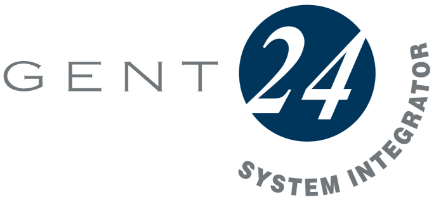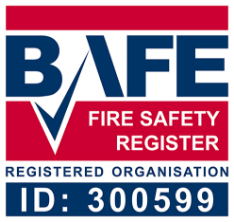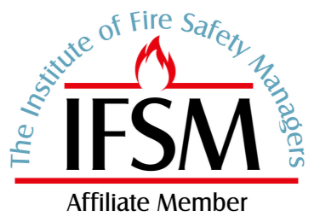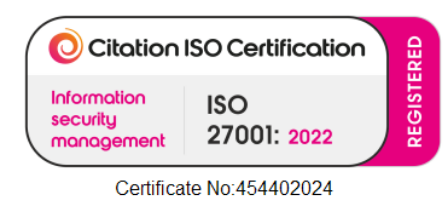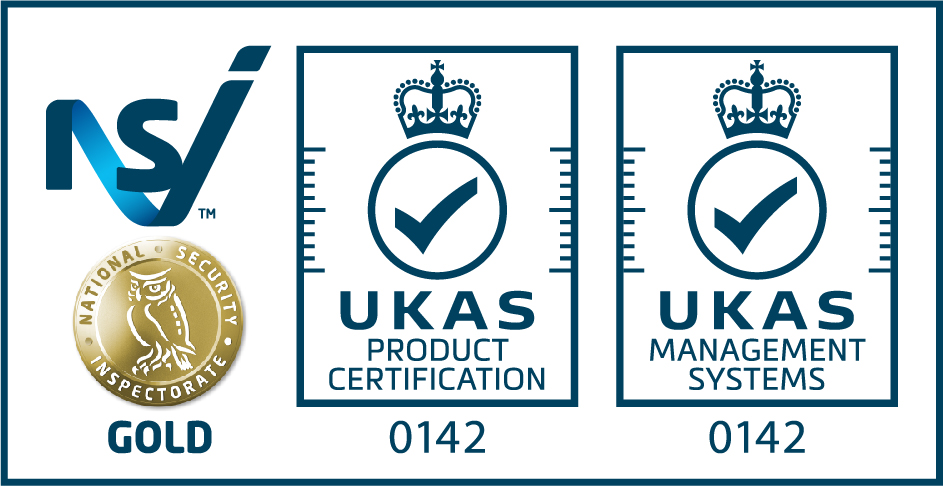Is your fire alarm system ready for 2025? As regulations tighten and enforcement increases across the UK, regular fire alarm system inspections are now essential for every business and public building.
This step-by-step guide takes the mystery out of compliance. You will learn how to navigate the inspection process, understand updated legal duties, and avoid costly penalties.
We will break down the latest UK regulations, show you how to schedule and prepare for inspections, and walk you through each inspection step. Discover common pitfalls, expert tips, and actionable strategies to keep your premises protected and compliant.
By the end, you will have the confidence and knowledge to ensure fire safety, protect lives, and safeguard your business for the year ahead.
Understanding Fire Alarm System Inspections in 2025
Keeping up with fire alarm system inspections is essential for every property manager and business owner in 2025. The regulatory landscape is changing rapidly, and understanding what is required can protect your premises, people, and reputation. Let’s break down what you need to know for the coming year.

Evolving UK Fire Safety Regulations
UK fire safety legislation is undergoing significant updates for 2025. The new regulations tighten requirements for fire alarm system inspections, with a particular focus on recordkeeping and inspection frequency. Key deadlines are set throughout the year, and penalties for non-compliance are rising. For example, fire safety enforcement actions increased by 30 percent between 2023 and 2024, and fines for missing or outdated inspection records are now commonplace.
These changes impact all commercial and public sector buildings. As seen in a recent case, a business faced a substantial fine after failing to provide up-to-date inspection documentation during a routine audit. For a clear overview of the latest legal requirements, consult the UK fire safety regulation updates 2025.
Why Inspections Are Critical
Regular fire alarm system inspections play a vital role in preventing fire incidents and safeguarding building occupants. Insurers now demand evidence of completed inspections, and failure to comply can void your cover or lead to legal action. According to the Fire Industry Association, over 60 percent of fire alarm failures are linked to missed maintenance.
Lives, assets, and business continuity all depend on a well-maintained system. In one notable incident, a recently inspected fire alarm enabled a swift evacuation, preventing injuries and minimising property damage. Routine inspections are not just a box-ticking exercise, they are a cornerstone of effective fire risk management.
Types of Fire Alarm Systems and Inspection Needs
Fire alarm system inspections must be tailored to the type of system in use. Conventional systems, common in small offices, require straightforward checks. Addressable and wireless systems, often found in hospitals or large facilities, demand more detailed testing and documentation. Hybrid systems blend both approaches, increasing inspection complexity.
| System Type | Inspection Frequency | Complexity |
|---|---|---|
| Conventional | Annual/Monthly | Low |
| Addressable | Biannual/Monthly | High |
| Wireless | Biannual/Monthly | Medium |
| Hybrid | Biannual/Monthly | High |
Proper documentation is crucial for every inspection. For example, an addressable system in a hospital needs zone charts and device logs, while a small office system may only require basic records. Always ensure your inspection process matches your system type.
Who Is Responsible for Inspections?
Legal responsibility for fire alarm system inspections lies with building owners, facilities managers, and designated responsible persons. These individuals must ensure all checks are completed by competent professionals, often accredited by recognised bodies. Inspectors need up-to-date certification and proven experience.
Many organisations delegate inspections to third-party accredited providers to guarantee compliance. Facilities managers often use detailed checklists to track annual inspection tasks and keep records current. Ultimately, maintaining compliance is a shared duty, but accountability remains with those in charge of the premises.
Step 1: Preparing for Your Fire Alarm System Inspection
Preparing for fire alarm system inspections is the foundation of effective fire safety management in 2025. A thorough approach not only minimises risk but also demonstrates compliance with evolving UK regulations. Before your next inspection, ensure your processes and paperwork are in order to avoid costly setbacks.
Reviewing Documentation and Maintenance Records
Maintaining up-to-date documentation is essential for fire alarm system inspections. Inspectors will request logbooks, service records, and certificates to verify your compliance history.
A missing or incomplete logbook can result in an automatic inspection failure. Ensure your records include:
- Dates of previous inspections and maintenance
- Details of any repairs or replacements
- System specifications and layout drawings
Regularly review and update these documents, as gaps can raise red flags for inspectors.
Scheduling Inspections and Notifying Occupants
Establish a clear inspection schedule to remain compliant. Most premises require weekly visual checks, monthly activations, biannual engineer visits, and annual full inspections.
Notify building occupants and stakeholders in advance. This reduces disruption and ensures everyone is aware of planned activities. Schedule inspections during quieter periods if possible, and communicate any temporary changes to evacuation routes or alarm usage.
Pre-Inspection System Checks
Before official fire alarm system inspections, conduct your own visual assessment. Look for damaged call points, missing signage, or obstructed detectors.
Make sure:
- Control panels and devices are accessible
- All manual call points are visible and undamaged
- Warning signs are legible and correctly placed
Quick fixes, such as clearing access or replacing signage, can prevent avoidable inspection issues.
Selecting a Qualified Inspector
Choose inspectors with recognised accreditations like BAFE, NICEIC, or NSI Gold. Ask for proof of credentials and insurance.
Third-party certified providers offer added assurance. They follow strict protocols and are up to date with the latest standards. This reduces the risk of non-compliance and ensures a thorough, unbiased inspection.
Fire Alarm System Inspection Services by Logic Fire and Security
Trusted support is vital when preparing for fire alarm system inspections. Fire alarm system services from Logic Fire and Security deliver accredited inspection, maintenance, and compliance solutions tailored to your premises.

Their expert team supports offices, warehouses, public buildings, and specialist environments, ensuring you meet all legal obligations. With over 20 years’ experience, Logic Fire and Security provides peace of mind through reliable, professional service.
Step 2: Conducting the Fire Alarm System Inspection
Conducting thorough fire alarm system inspections is essential for maintaining safety and legal compliance. This step involves a systematic review of every component, testing, and accurate documentation. Each process ensures your system is reliable when it matters most.
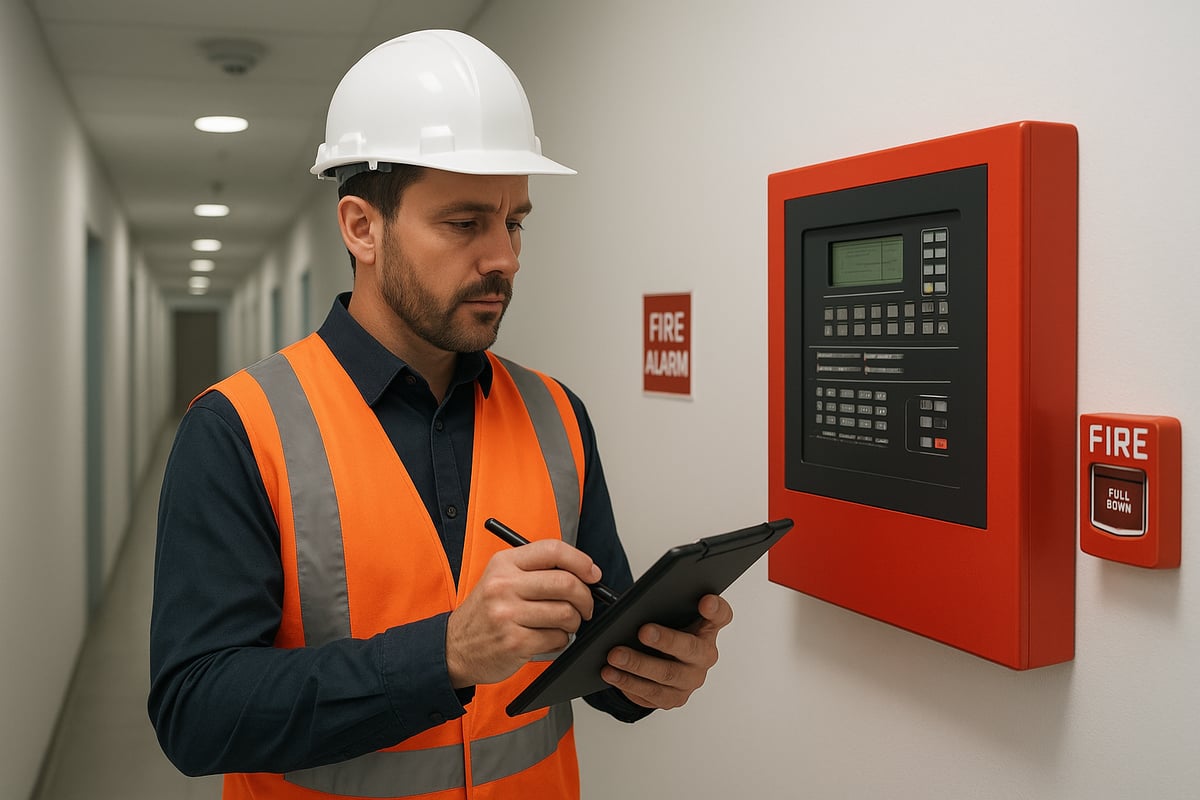
Visual Inspection of All Components
Begin with a careful visual inspection of all fire alarm system components. Inspect the control panel, detectors, manual call points, sounders, and wiring. Look for physical damage, tampering, or anything blocking access.
Common issues include storage boxes placed below detectors or missing signage. Ensure every detector and call point is visible and unobstructed. Address any visible faults immediately to avoid failing fire alarm system inspections.
- Check for dust or debris on detectors.
- Confirm call points are intact and accessible.
- Inspect sounders for any signs of damage.
Testing Alarm Functionality and Devices
Next, test the functionality of each device. Activate manual call points to trigger the alarm and check that all sounders operate at the correct volume. Use approved test equipment to simulate smoke, heat, or carbon monoxide for detector testing.
If you encounter a false alarm trigger, investigate the cause and reset the system only after confirming there is no real danger. For full compliance, follow the BS 5839-1:2025 fire alarm standard, which outlines best practices for testing and maintenance of fire alarm system inspections.
Verifying System Communication and Integration
Check the integration of your fire alarm system with other building safety features. Confirm that the system communicates properly with emergency lighting, fire doors, and suppression systems.
Test for reliable connectivity with remote monitoring or alarm receiving centres. Integration faults account for a significant portion of system failures, so verify all connections are secure and operational.
- Inspect interface units for correct wiring.
- Check fire doors close automatically on alarm.
- Test emergency lighting activation during alarm events.
Assessing Power Supplies and Backups
Reliable power is vital for fire alarm system inspections. Test the main power supply and ensure battery backups are fully functional. Inspect battery chargers, battery terminals, and connectors for corrosion or wear.
A real incident can expose weaknesses, such as a depleted backup battery, leading to total system failure. Replace any batteries nearing end of life and confirm power changeover operates seamlessly.
- Check battery voltage with a multimeter.
- Inspect chargers for faults or loose connections.
- Record all power test results.
Reviewing Zone Charts and System Labelling
Accurate zone charts must be displayed at each control panel. These charts help emergency responders quickly identify affected areas during an incident.
Ensure all system labels, including detector and call point numbers, match the documentation. Update any outdated or missing charts. Proper labelling streamlines troubleshooting during fire alarm system inspections.
Recording and Reporting Inspection Findings
Complete a detailed inspection report at the end of your checks. Record all findings, deficiencies, and recommended actions. Use a standard format that includes dates, inspector details, and system status.
A comprehensive report supports ongoing compliance and can be vital during regulatory audits. Keep both digital and paper copies for easy access and future reference.
Step 3: Addressing Common Issues and Remediation
Identifying Frequent Inspection Failures
Even with regular fire alarm system inspections, common failures can still occur. These include missing or outdated documentation, faulty detectors or sounders, and poor system labelling. For example, failing to replace batteries can cause unexpected downtime at critical moments.
A missed record update or neglected component can result in compliance breaches. Being aware of these frequent pitfalls helps you address them before they escalate.
Rectifying Detected Faults
When faults are discovered during fire alarm system inspections, immediate action is essential. Some issues, such as failed detectors or flat batteries, require urgent repair. Others, like worn signage or minor wiring faults, may be scheduled for later.
Always document any remedial work and ensure replacement parts meet industry standards. A thorough response maintains both safety and compliance with regulations.
Preventing False Alarms and Nuisance Triggers
False alarms disrupt operations and erode trust in your fire alarm system inspections. Dust, steam, cooking fumes, or incorrect detector placement are frequent causes. Regular cleaning, correct zoning, and targeted staff training are effective solutions.
For a holistic approach to fire safety, consider reviewing this fire extinguisher inspection guide to complement your alarm maintenance practices.
Ensuring Ongoing Compliance
Sustaining compliance after fire alarm system inspections involves more than just repairs. Set up automated reminders for maintenance and inspections. Train staff to report faults promptly and hold regular fire drills.
A compliance calendar for facilities managers streamlines tasks and ensures nothing is overlooked. Consistency is key to passing future audits with confidence.
When to Consider System Upgrades
Frequent problems or outdated technology signal it may be time to upgrade. Changes in building use or layout can also affect your fire alarm system inspections and their effectiveness.
Upgrading to addressable or wireless systems offers better reliability and flexibility. Enhanced features support both current compliance and future-proof your premises.

Step 4: Post-Inspection Actions and Record Keeping
Keeping your fire alarm system inspections process robust does not end when the inspection itself is complete. The post-inspection phase is crucial for maintaining full compliance and ensuring your premises remain protected and audit-ready.
Updating Inspection Records and Certificates
Accurate and up-to-date records are a legal requirement for fire alarm system inspections. Whether you use digital platforms or paper logbooks, every test, maintenance, and inspection must be logged promptly.
Inspectors will issue compliance certificates, which should be stored securely and made easily accessible. Multi-site businesses often benefit from digital recordkeeping, which streamlines updates and retrievals. For detailed guidance on maintaining compliant records and certificates, see the fire alarm servicing compliance 2025 requirements.
Communicating Results and Next Steps
Once fire alarm system inspections are complete, share the findings with all relevant stakeholders. This includes facilities teams, senior management, and, where required, your insurance provider.
Use clear templates to summarise any actions needed or compliance achieved. Transparent communication helps everyone understand their responsibilities and ensures that the next steps, such as remedial actions, are actioned without delay.
Scheduling Follow-Up Maintenance or Repairs
If your inspection identifies any faults, schedule follow-up maintenance promptly. Distinguish between urgent and routine issues to prioritise safety and compliance.
Work closely with your service provider to coordinate repairs at a convenient time, minimising disruption to building users. Regular follow-up is key to the ongoing success of fire alarm system inspections.
Training Staff and Occupants
Post-inspection, brief staff and occupants on any changes to systems or procedures. This may involve updates to fire evacuation protocols or refresher training on using manual call points.
Regular fire drills and induction checklists keep everyone prepared. Integrating these activities into your fire alarm system inspections cycle supports a culture of safety and readiness.
Preparing for Regulatory Audits
Be ready for fire safety audits by ensuring all documentation and certificates are organised and accessible. Auditors will expect to see comprehensive records of fire alarm system inspections and any remedial actions taken.
A detailed audit checklist can help property managers avoid missing critical items. For a broader compliance perspective, refer to the fire risk assessment process, which complements your inspection regime.
Expert Tips for Streamlining Fire Alarm Inspections in 2025
Staying on top of fire alarm system inspections in 2025 requires more than just ticking boxes. With evolving regulations and tighter enforcement, a strategic, proactive approach can save time, money, and stress. Here are five expert tips to help you streamline compliance and keep your premises protected.
Leveraging Technology for Efficient Inspections
Harnessing digital solutions can transform how you manage fire alarm system inspections. Mobile apps allow inspectors to log findings instantly, schedule follow-up actions, and store digital records. Automated reminders ensure routine checks are never missed.
- Use cloud-based platforms for secure document storage
- Enable real-time reporting for multi-site operations
- Integrate inspection data with maintenance schedules
A recent case study showed that businesses adopting digital tools reduced admin time by 40 percent, freeing resources for more critical safety tasks.
Building a Proactive Maintenance Culture
A proactive culture is vital for consistent fire alarm system inspections. Regular staff training ensures everyone understands their role in fire safety. Encourage prompt reporting of faults and near-misses to address issues before they escalate.
- Hold monthly team briefings on inspection outcomes
- Distribute quick-reference guides for common faults
- Recognise and reward vigilant behaviour
This approach fosters shared responsibility and reduces the likelihood of missed inspections or overlooked hazards.
Choosing the Right Service Partner
Selecting a trusted provider is key to reliable fire alarm system inspections. Look for partners with BAFE, NICEIC, or NSI Gold accreditations to guarantee expertise and compliance.
- Assess response times and customer support quality
- Compare in-house teams with outsourced specialists
- Consider long-term maintenance contracts for continuity
A well-chosen partner brings peace of mind and helps you navigate the complexities of changing regulations.
Staying Ahead of Regulatory Changes
Regulations for fire alarm system inspections continue to evolve. Stay informed by subscribing to industry newsletters and following updates from government bodies. Review your internal policies regularly to ensure ongoing compliance.
For a comprehensive approach, consider related requirements such as fire door inspection requirements, which are often audited alongside alarm systems. Proactive monitoring helps you avoid costly surprises during official audits.
Cost-Saving Strategies Without Compromising Safety
You can optimise your fire alarm system inspections without cutting corners. Bundle inspection and maintenance services for better value, and invest in energy-efficient or smart detection upgrades to reduce long-term costs.
| Strategy | Benefit |
|---|---|
| Bundled service contracts | Lower per-inspection costs |
| Digital recordkeeping | Reduced admin overhead |
| Smart system upgrades | Fewer false alarms |
According to fire prevention and protection statistics 2024, robust compliance efforts can lead to insurance savings of up to 20 percent. Smart planning keeps your premises safe and your budget healthy.
As you look ahead to 2025, staying proactive with your fire alarm system inspections is an essential step in protecting your people, property, and business continuity. We’ve explored how clear documentation, the latest compliance standards, and expert support can make all the difference—especially with evolving regulations across the UK. If you want confidence that your site’s fire safety is in expert hands, why not take the next step? You can arrange a tailored, no obligation assessment to identify exactly what your premises need to stay compliant and secure. Ready to get started? Get a Free Site Survey


